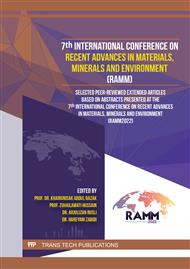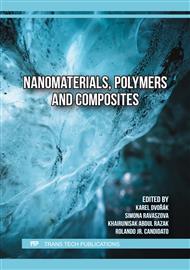[1]
J. P. G. L. Frias and R. Nash, "Microplastics: Finding a consensus on the definition," Mar Pollut Bull, vol. 138, p.145–147, Jan. 2019.
DOI: 10.1016/j.marpolbul.2018.11.022
Google Scholar
[2]
M. Padervand, E. Lichtfouse, D. Robert, and C. Wang, "Removal of microplastics from the environment. A review," Environ Chem Lett, vol. 18, no. 3, p.807–828, May 2020.
DOI: 10.1007/s10311-020-00983-1
Google Scholar
[3]
J. Vollertsen and A. A. Hansen, "Microplastic in Danish wastewater: Sources, occurrences and fate," Mar. 2017.
Google Scholar
[4]
H. Lee and Y. Kim, "Treatment characteristics of microplastics at biological sewage treatment facilities in Korea," Mar Pollut Bull, vol. 137, p.1–8, Dec. 2018.
DOI: 10.1016/j.marpolbul.2018.09.050
Google Scholar
[5]
K. Conley, A. Clum, J. Deepe, H. Lane, and B. Beckingham, "Wastewater treatment plants as a source of microplastics to an urban estuary: Removal efficiencies and loading per capita over one year," Water Res X, vol. 3, p.100030, Apr. 2019.
DOI: 10.1016/j.wroa.2019.100030
Google Scholar
[6]
N. Ajith, S. Arumugam, S. Parthasarathy, S. Manupoori, and S. Janakiraman, "Global distribution of microplastics and its impact on marine environment—a review," Environmental Science and Pollution Research, vol. 27, no. 21, p.25970–25986, Jul. 2020.
DOI: 10.1007/s11356-020-09015-5
Google Scholar
[7]
A. H. Hamidian, E. J. Ozumchelouei, F. Feizi, C. Wu, Y. Zhang, and M. Yang, "A review on the characteristics of microplastics in wastewater treatment plants: A source for toxic chemicals," J Clean Prod, vol. 295, p.126480, May 2021.
DOI: 10.1016/j.jclepro.2021.126480
Google Scholar
[8]
R. Gautam, A. S. Bassi, and E. K. Yanful, "A review of biodegradation of synthetic plastic and foams," Appl Biochem Biotechnol, vol. 141, no. 1, p.85–108, Apr. 2007.
DOI: 10.1007/s12010-007-9212-6
Google Scholar
[9]
A. Ahmad, "Why Silver and PMMA are commonly used materials in plasmonic?," 2019. https://www.researchgate.net/post/Why-Silver-and-PMMA-are-commonly-used-materials-in-plasmonics/5d1e027d3d48b730cf45e24c/citation/download (accessed Jul. 07, 2021).
Google Scholar
[10]
D. A. Maulana, M. Ibadurrohman, and Slamet, "Synthesis of nano-Composite Ag/TiO 2 for polyethylene microplastic degradation applications," IOP Conf Ser Mater Sci Eng, vol. 1011, no. 1, p.012054, Jan. 2021.
DOI: 10.1088/1757-899X/1011/1/012054
Google Scholar
[11]
A. Uheida, H. G. Mejía, M. Abdel-Rehim, W. Hamd, and J. Dutta, "Visible light photocatalytic degradation of polypropylene microplastics in a continuous water flow system," J Hazard Mater, p.124299, Oct. 2020.
DOI: 10.1016/j.jhazmat.2020.124299
Google Scholar
[12]
N. Isa, S. H. Sarijo, A. Aziz, and Z. Lockman, "Synthesis colloidal Kyllinga brevifolia-mediated silver nanoparticles at different temperature for methylene blue removal," in AIP Conference Proceedings, Sep. 2017, vol. 1877, no. 1, p.070001.
DOI: 10.1063/1.4999887
Google Scholar
[13]
N. Isa and Z. Lockman, "Methylene blue dye removal on silver nanoparticles reduced by Kyllinga brevifolia," Environmental Science and Pollution Research, vol. 26, no. 11, p.11482–11495, Apr. 2019.
DOI: 10.1007/s11356-019-04583-7
Google Scholar
[14]
S. T. Rahmat, W. K. Tan, G. Kawamura, A. Matsuda, and Z. Lockman, "Facile fabrication of rGO/rutile TiO2 nanowires as photocatalyst for Cr(VI) reduction," Mater Today Proc, vol. 17, p.1143–1151, Jan. 2019.
DOI: 10.1016/j.matpr.2019.06.543
Google Scholar
[15]
S. T. Rahmat, W. K. Tan, G. Kawamura, A. Matsuda, and Z. Lockman, "Synthesis of rutile TiO2 nanowires by thermal oxidation of titanium in the presence of KOH and their ability to photoreduce Cr(VI) ions," J Alloys Compd, vol. 812, p.152094, Jan. 2020.
DOI: 10.1016/j.jallcom.2019.152094
Google Scholar
[16]
X. Peng and A. Chen, "Aligned TiO2 nanorod arrays synthesized by oxidizing titanium with acetone," J Mater Chem, vol. 14, no. 16, p.2542, Jun. 2004.
DOI: 10.1039/b404750h
Google Scholar
[17]
X. Peng, J. Wang, D. F. Thomas, and A. Chen, "Tunable growth of TiO 2 nanostructures on Ti substrates," Nanotechnology, vol. 16, no. 10, p.2389–2395, Oct. 2005.
DOI: 10.1088/0957-4484/16/10/066
Google Scholar
[18]
O. Frank, M. Zukalova, B. Laskova, J. Kürti, J. Koltai, and L. Kavan, "Raman spectra of titanium dioxide (anatase, rutile) with identified oxygen isotopes (16, 17, 18)," Physical Chemistry Chemical Physics, vol. 14, no. 42, p.14567–14572, Oct. 2012.
DOI: 10.1039/C2CP42763J
Google Scholar
[19]
J. Du et al., "Hydrophilic TiO 2 nanowires prepared on Ti 5 Si 3 layer by chemical vapour deposition," J Chem Res, vol. 41, no. 5, p.304–308, May 2017.
DOI: 10.3184/174751917X14932244903872
Google Scholar
[20]
S. Elzey and V. H. Grassian, "Agglomeration, isolation and dissolution of commercially manufactured silver nanoparticles in aqueous environments," Journal of Nanoparticle Research, vol. 12, no. 5, p.1945–1958, Jun. 2010.
DOI: 10.1007/s11051-009-9783-y
Google Scholar
[21]
A. Gopanna, R. N. Mandapati, S. P. Thomas, K. Rajan, and M. Chavali, "Fourier transform infrared spectroscopy (FTIR), Raman spectroscopy and wide-angle X-ray scattering (WAXS) of polypropylene (PP)/cyclic olefin copolymer (COC) blends for qualitative and quantitative analysis," Polymer Bulletin, vol. 76, no. 8, p.4259–4274, Aug. 2019.
DOI: 10.1007/s00289-018-2599-0
Google Scholar



